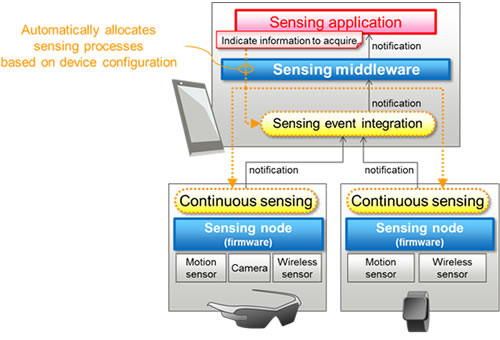Kawasaki, Japan, December 05, 2014
Fujitsu Laboratories Ltd. today announced that it has developed sensing middleware that can simplify development of low-power sensing applications needed by wearable devices. This will enable the creation of a usage environment in which a variety of wearable devices can be worn naturally, without user concern.
Many wearable devices require battery power, so there has been a need to build in applications that can allow for long run times.
Fujitsu Laboratories has now developed sensing middleware that automatically differentiates sensors installed on each device so as to operate them at the lowest power levels possible, eliminating the need to build in to each individual sensor. By incorporating firmware that supports this middleware into wearable devices, application developers can easily create low-power applications with approximately one-tenth the work previously required, simply by specifying the activity sensors and ambient sensors from which they want to acquire information.
By spreading the use of this technology, Fujitsu Laboratories seeks to promote the development of wearable devices that are capable of continuous sensing with the aim of helping to bring about a society which can easily adopt a variety of ICT services, such as hands-free onsite work assistance or automated recording of detailed work logs.
Background
Smartphones and other mobile devices are equipped with a variety of sensors, which are used in new services such as support in finding nearby stores and health management. In recent years, numerous wearable devices have emerged, and as they gather ever more data on the locations and activities of people who wear them, there are expectations that services will become increasingly customized.
Wearable devices have great potential to make ICT accessible in the workplace, especially on the frontlines of maintenance, manufacturing, and retailing. Unlike smartphones or tablets, wearable devices enable hands-free access to information. This means work can continue without being interrupted by having to operate a device. In factories, warehouses, hospitals, or stores, these could be used to give directions to a location where a task will be performed while walking, and to give instructions on the task once the operator arrives at the location, delivering just the information that is needed, when it is needed, based on the operator's activity and surroundings. This has the potential to cut down on operator errors and improve operator efficiency (Figure 1).
 Figure 1: Example of a wearable device being used for workplace assistance
Figure 1: Example of a wearable device being used for workplace assistance
Technological Issues
Delivering timely information to people based on their current situation without requiring them to consciously operate a device requires constant data collection. But because smartphones and wearables operate on battery power, developing applications and supporting services requires sophisticated techniques to use sensors without excessive battery drain.
In the case of smartphones, it is relatively easy to develop various applications that use sensors, thanks to sensor APIs, but to restrict the active sensors to the minimum needed and provide precise control over power requires sophisticated programming skills and considerable effort that would only be available to a specialist. Another way that smartphones can reduce power usage is to leave sensor processing to low-power microcontrollers, but that requires custom firmware development for each process.
About the Technology
Fujitsu Laboratories has developed a framework that will simplify development of low-power sensing applications (Figure 2).
Features of the new technology are as follows:
- Sensing middleware
This middleware intercepts and handles requests for notification from applications, automatically reducing the power drain on wearables. The process works as follows:
- The middleware monitors the connection status of the wearable device, and acquires sensor information that can be used.
- When it receives a request from an application, it checks the request against the sensor information, and is able to determine the combination of active sensors that will involve the minimum amount of power based on the sensors' power consumption and communication frequency.
- It instructs each wearable device to continue sensing processes based on the combination of active sensors.
- After being instructed, the wearable device will continue its sensing processes, and the smartphone will remain in low-power standby mode until it receives a report from the wearable device.
This is how the middleware automatically selects low-power sensing methods based on an application's requests.
- Sensing nodes
This is a firmware module in the wearable device that runs continuous sensing processes as instructed by the sensing middleware. Using sensors and a low-power processor in the wearable device, this is able to acquire sensor data, process it, and perform conditional decisions, at low power to allow for long runtimes. The node can change its processing profile and perform a variety of sensing tasks as needed by the application in response to new instructions from the middleware.
 Figure 2: Overview of sensing application development framework
Figure 2: Overview of sensing application development framework
Results
This technology simplifies the process of developing applications that use continuous sensing, without requiring any specialized knowledge of sensing technologies or power management, and cuts the amount of work required to build solutions that use sensing by 90%, while reducing power requirements by more than two-thirds. Additionally, a single application can support multiple similar wearable devices with no rewrites, as long as the sensing nodes are equipped with compatible firmware.
Until now, every low-power solution for wearable devices has required a one-off effort, but with this technology, the customizing work required on the wearable end is dramatically reduced, which shortens development cycles and costs, and promises new solutions and uses for wearable devices.
Future Plans
Fujitsu Laboratories aims to offer practical implementation of this technology during fiscal 2015. Meanwhile, the company plans to release the interface specification for wearable devices to support this technology to device makers, and will promote development of supporting devices.
![]() E-mail: mobilesensing-pr@ml.labs.fujitsu.com
E-mail: mobilesensing-pr@ml.labs.fujitsu.com
